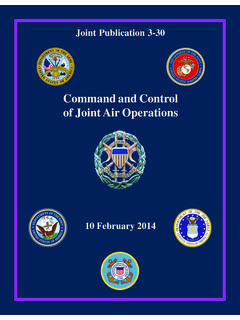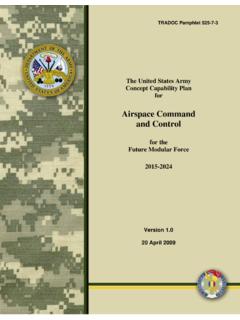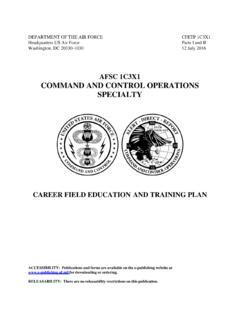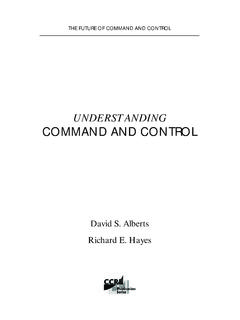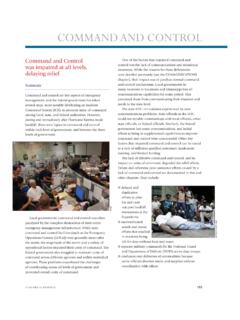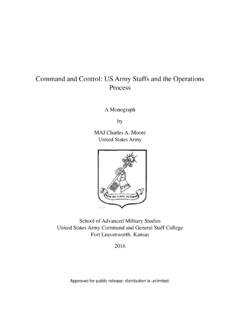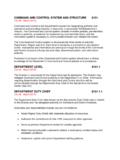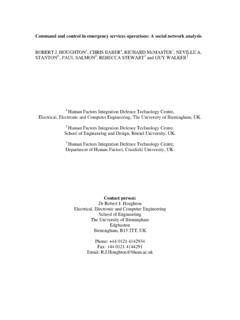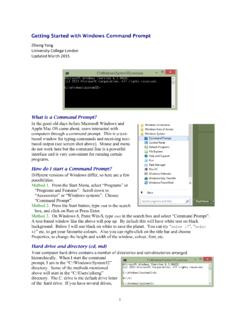Transcription of JFQ - Defense Technical Information Center
1 40 JFQ/ Autumn/Winter 2001 02 Forces of the future will be able tooverwhelm any enemy in despite extensive study of theimpact of new technologies, there hasbeen insufficient analysis on how suchinnovations will affect political over-sight. This dearth in the literature hasbeen particularly glaring with regardsto alliance and coalition warfare. Thepolitical leadership of any assemblageof democracies will want to exploitgreater speed in order to bring a waror peace enforcement operation to aquick and just conclusion. Given thatWestern democracies only rarelyMany advocates of a revo-lution in military affairsargue that technologicalbreakthroughs will bringgreater operational speed. Global com-munications systems spurred by theexplosion in microprocessing and digi-tal technologies will provide com-manders with unprecedented advan-tages.
2 Given such advances, there hasbeen speculation that the ArmedThomas-Durell Young is the European program manager for the Center for Civil-Military Relations at the Naval Postgraduate School and the coauthor of NATOA fter 2000: The Future of the Euro-Atlantic and control for the 21stCenturyBy THOMAS-DURELL YOUNGUSS Theodore Roosevelt,Allied Navy (William L. Vandermate) 1029 Young Pgs 3/12/02 2:28 PM Page 40 Report Documentation PageReport Date 00 00 2002 Report Type N/ADates Covered ( to) - Title and Subtitle nato command and control for the 21st CenturyContract Number Grant Number Program Element Number Author(s) Project Number Task Number Work Unit Number Performing Organization Name(s) and Address(es) National Defense University Institute for NationalStrategic Studies Washington D C 20319-5066 Performing Organization Report Number Sponsoring/Monitoring Agency Name(s) and Address(es) Sponsor/Monitor s Acronym(s) Sponsor/Monitor s Report Number(s)
3 Distribution/Availability Statement Approved for public release, distribution unlimitedSupplementary Notes The original document contains color Subject Terms Report Classification unclassifiedClassification of this page unclassifiedClassification of Abstract unclassified Limitation of Abstract UUNumber of Pages 6 YoungAutumn/Winter 2001 02 /JFQ41conduct operations unilaterally, theimmediacy of this issue takes onadded oversight in alliancesand coalitions is effected by a formalstanding body like the North AtlanticCouncil or through ad hoc politicalconsultative forums. It becomes theprovince of multinational parties in ei-ther case. In the North Atlantic TreatyOrganization ( nato ), decisionmakingby 19 nations often occurs at a lan-guid pace that may not be conduciveto high-speed maneuvers.
4 This shouldcome as no surprise, given that gov-ernments are loath to surrender theirforces to foreign command withoutprovision for close political monitor-ing. The success of nato as a long-standing military alliance and thegrowing worldwide application of itsbasic procedures make it worthwhileto revisit the current definitions andpractices of its command authorities,their compatibility with the expecta-tion of a revolution in military affairs,and the capacity of nato to translatefuture political decisions into rapidmilitary Challenge of ChangeDelegation of command authorityto multinational commanders remainsone of the least developed areas of Al-liance force employment policy. Landoperations present singular problemsbecause ground commanders requiregreater authority than naval and aircommanders.
5 The missions and opera-tional limitations of ships and aircraftare a function of their design. Navalvessels and planes can best be thoughtof as integral weapons and systems plat-forms that can be allocated to nonna-tional commanders for specific for naval and air forces, only afew command authorities need betransferred to a multinational forces, on the other hand, arecombined arms teams that must be or-ganized for a specific mission. Thecross-assignment of units, the frequentneed to change missions rapidly to re-spond to a developing situation, andthe legitimate need for a commander toestablish supply and training prioritiesare among the more sensitive powersnations are reluctant to turn over to anAlliance four official levels of nato command authority operational com-mand (OPCOM), operational control (OPCON), tactical command (TACOM),and tactical control (TACON) havenot been revised since the early 1980s(see table 1).
6 Their definitions are legal-istic and not readily do not cover importantpeacetime responsibilities appropriatefor multinational formations such astraining, readiness, and logistics. Be-cause of broad nato interpretations ofcommand authorities, members oftenindulge in the practice of employingcaveats, creating even more ambiguousterms such as OPCON+ and OPCOM .During peacetime, with the exceptionof I German-Netherlands Corps, multi-national commanders of formationsearmarked for nato do not have com-mand authority per se. Rather, theywield coordination authority, whichdoes not allow any directive control . Navy (William L. Vandermate)Table 1. nato AuthoritiesOperational command (OPCOM)The authority granted to a commander to assign missions or tasks to subordinate commanders, todeploy units, to reassign forces, and to retain or delegate operational and/or tactical control as may bedeemed necessary.
7 It does not of itself include responsibility for administration or logistics. May also beused to denote the forces assigned to a control (OPCON)The authority delegated to a commander to direct forces assigned so that the commander mayaccomplish specific missions or tasks which are usually limited by function, time, or location; to deployunits concerned; and to retain or assign tactical control to those units. It does not include authority toassign separate employment of components of the units concerned. Neither does it, of itself, includeadministrative or logistic command (TACOM)The authority delegated to a commander to assign tasks to forces under his command for theaccomplishment of the mission assigned by higher control (TACON)The detailed and usually local direction and control of movements or maneuvers necessary toaccomplish missions or tasks AuthorityThe authority granted to a commander or individual assigned responsibility for coordinating specificfunctions or activities involving forces of two or more countries or commands, or two or more services, ortwo or more forces of the same service.
8 He has the authority to require consultation between the agenciesinvolved or their representatives but does not have the authority to compel agreement. In case ofdisagreement between the agencies involved, he should attempt to obtain essential agreement bydiscussion. In the event he is unable to obtain essential agreement he shall refer the matter to theappropriate Directing and control Authority (employed only by commanding general, I German-Netherlands Corps)This authority provides the commander with powers that are identical or similar to those vested in acommander of a national corps or with powers that are altogether new. Sovereign national rights (in thenarrowest sense) are excepted. The commanding general has the right to give instructions to allsubordinate military and civilian personnel and may issue directives to the binational and nationalelements of the corps and set : nato Glossary of Terms and Definitions.
9 1029 Young Pgs 3/12/02 2:28 PM Page 41 JFQ FORUM42 JFQ/ Autumn/Winter 2001 02 Three Faces of the New NATOC ommanders have discoveredthree trends that are reshaping howAlliance capabilities are multinational land forces wasalmost exclusively effected on thecorps level during the Cold War, theexception being Multinational CorpsNortheast (located in Stettin, Poland).To protect force structure and main-tain expertise on higher levels of com-mand, there exist multinational landformations declared to the Alliancedown to corps and even division lev-els. Sadly, there is no nato policy, letalone a common approach, to estab-lishing command authority require-ments on specific levels of , there has been no con-certed effort among the 19 membersto ascertain if current definitionsmatch the mission requirements ofmultinational force commanders.
10 Tobe sure, issues related to administra-tion (such as promotions and trans-fers), referred to in nato as full com-mand,will always remain within thepurview of a sovereign state. Yet noone would seriously challenge the re-sponsibility of a national corps or division commander to meet thetraining and readiness standards setout by higher authorities. Commandarrangements and practices in nato hinder the achievement of these goalsat missions. The range of possi-ble tasks for forces declared to NATOhas increased dramatically. Serving asreaction forces for non-Article 5 peacesupport operations is the dominantmission of most elements, as opposedto meeting less immediate collectiveself Defense missions. These new oper-ations have two important characteris-tics.










